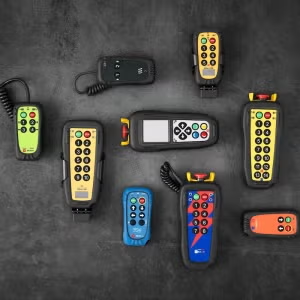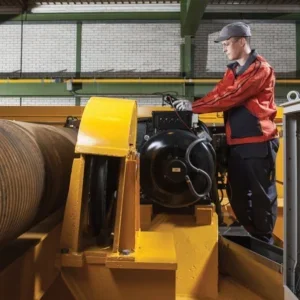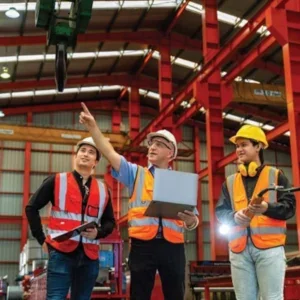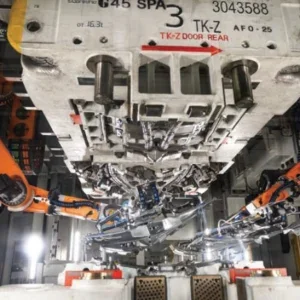Hoist spoke to four companies working in a range of industries across the region, and to an end-user in the power industry, to see how business is faring in 2010, and found that experiences vary widely across the region.
Bushman AvonTec manufactures built-to-order material handling equipment including below-the-hook lifting equipment for mill duty and industrial applications, floor-based material handling equipment and slit coil packaging equipment. “Most of our sales are to steel manufacturers and steel processors in Ontario,” explains corporate vice-president Robyn Deger. “We also sell products to paper mills and to producers of nickel and zinc in Ontario and Quebec, and are currently building several machines for the oil industry in western Canada.”
But, she says, “business levels are still very depressed. Quoting activity is very high and our customer contacts are hopeful of improving conditions, but order levels don’t yet support the optimistic outlook in Canada.”

COH works across the North American continent, and is currently executing projects in both the west (British Columbia) and east of Canada (Ontario, Quebec and Nova Scotia), and in north eastern and southern USA (Maryland and Alabama). It serves many industry sectors, principally power generation, but also light and heavy metals, cement, pulp and paper, aeronautic and automotive, with custom and medium to large capacity overhead cranes, gantry cranes and other lifting equipment.
“As did most manufacturers, we saw a net drop in sales in 2009, especially as 2008 was very good for COH,” explains COH’s sales and marketing manager, Stéphane Laurin. “We see activity picking up slowly in 2010 as people have come to realise that business must go on. Capital equipment takes some time to build and there is only so much that end users can do to extend the life of existing equipment or delay new purchases.”
The Americas arm of international giant Konecranes works in all sectors of Canadian industry and throughout all the provinces. “We’re finding the situation is less volatile now than it was in the same period a year ago,” says Scott Gilbey, vice president of marketing and communications for Konecranes in the Americas. “Sales are relatively stable and we are cautiously optimistic about the future.”
M&L Testing is the newly appointed Canadian distributor for Straightpoint, and works across the country, with office, warehouse and service facilities in Ontario and Alberta.
It focuses on supplying testing equipment for field and laboratory use for producers of aggregate, concrete, cement, plastics, oil, gas, aerospace and shipping industries, and also serves local authority sectors and manufacturers.
M&L offers complete servicing of all equipment sold across its client base, and electronic, electrical, hydraulic and mechanical in house and on site calibrations to SSA and ASTM specifications.
“Business is booming, with sales on a par with or better than last year,” says the company’s president, Mike Mizener. “The Canadian government has invested heavily in infrastructure over the next five years, which should keep things in our industry very busy for that many years at least.”
Handling production capacity has also varied across the four companies, with Deger reporting that Bushman AvonTec has had to make “several employees” redundant, but Mizener says that M&L Testing has not had to make any production cutbacks. Gilbey says production capacities were adjusted according to demand throughout 2009 in all Konecranes production units, while Laurin explains: “We have been able to keep our facilities in operation at COH, again, thanks to the backlog of activity resulting from our 2008 sales. As this year progresses, some rationalisation is taking place to make sure we remain competitive; for example, we have slightly reduced our workforce without affecting our capability to bounce back when needed.”
And when that bounce-back comes, they are ready for it in different ways. M&L Testing is preparing to launch its new website. “We have not seen a ‘downtime’ and don’t expect to,” says Mizener. “Our market is strong and looks set to get stronger over the next five to 10 years. We’re very optimistic about the opportunities in the Canadian market.”
Konecranes, says Gilbey, “is putting special efforts into streamlining its processes and organisation. We have continued to invest in R&D and IT, and have put a lot of emphasis on personnel training and new product development. We are about to launch Konecranes’ Smart Solutions, an array of technology options that includes sway control, shock control and other features to enhance safety and increase productivity.”
“We have kept all our facilities in operation and retained all our key personnel, as we knew this was only a temporary situation. So we’ll be ready the moment things take off again,” says Laurin. “Since we build custom equipment, we’re not like other manufacturers who spend on R&D to optimise a standard design that will be built to hundreds or thousands of units. R&D at COH is a continuing process of improvement whereby we identify new design components to make the final product better and cost-effective.”
Bushman AvonTec has relocated to a newer, larger facility in Hamilton, Ontario, centrally located near its key customers. Last October, it re-branded itself (from Bushman Equipment Inc to Bushman AvonTec), bringing together the parent company and its two divisions, West Bend Equipment and Avon Engineering, to form a single source supplier.
“We recently developed an improved automatic ‘spacer placer’ for slit coil packaging lines,” says Deger. “The recent ‘downtime’ was consumed by our factory relocation and marketing efforts. We also have an all new website and new sales literature and have obtained ISO 9001 – 2008 registration.”
End users
Have any end-user markets shown immunity to the recession?
Deger says that, from Bushman’s perspective, none were immune to its effects. But Gilbey reports: “Activities in power generation, such as wind energy, nuclear power and waste-to-energy, remained the most stable or were least affected by the economic downturn in 2009. No specific product segment provided any more shelter than another. But trends that were previously quite volatile generally remained consistent through the latter half of 2009.”
“Because of our location in Quebec, hydropower generation has always been one of our key sectors of activity,” explains Laurin. “While the construction of new dams and generating stations has not been very strong, the upgrade of ageing infrastructure, related to safety concerns or capacity increase, has generated some interesting business. Electricity demand is here to stay and increase. Power generators have to keep up and increase their production capacity and so require larger turbines that require more crane capacity. This trend has remained consistent throughout the crisis, although some projects have been delayed because funding was more difficult to get, even though offering a good ROI for the banks.”
When will the market recover?
“Our business is typically six to 12 months behind the curve,” thinks Deger. “Our customers need to see their business levels improve before they commit to buying capital equipment. Enquiries are up significantly from last year, which tells us that our customers are seeing improvement and are preparing to make equipment purchases.”
Konecranes agrees: “We typically experience economic cycles that lag behind other indicators,” says Gilbey. “Crane and lifting industries will recover behind the general industrial curve as it takes time for our customers to improve their utilisation rates, or to act on their planned investments to expand production or improve productivity.”
Laurin is bullish. “Serving different industries, we can see they’ll pick up at different times, so we stay close to each of them in order to stay ahead,” he says. “We see activity resuming in most of our traditional sectors — hydropower is still strong and metals, both light (aluminium) and heavy (steel) are showing signs of pick-up. We have new projects ready to go on aluminium and the steel industry.”
Looking ahead, Deger thinks that, based on customer comments and current enquiries, Bushman AvonTec can expect an improvement in orders through the second half of 2010 and steady, moderate growth in 2011.
But Gilbey sounds a note of caution: “The year 2009 was unusually tough for the entire industry and no one can predict with any degree of certainty what 2010 and 2011 will have in store.”
Standards
Two years ago, the Canadian Standards Association (CSA) revised the B167 overhead travelling and portal bridge crane standard in an effort to fully comply with the world international ISO-4301 crane standard. Judy Mellott-Green is president and CEO of the All Canadian Training Institute (ACTi) in Edmonton, Alberta, which provides safety training across Canada and the territories for all industries with overhead cranes.
“The new standard is applicable to all overhead lifting equipment in Canada,” she says. “One of its major components is the stipulation that no one may be permitted to operate this equipment without proper safety training.”

Has this standardisation worked?
Gilbey is doubtful, saying: “Implementation of this kind of regulatory change often takes time to have a visible impact on the industry.” Laurin adds: “As we build custom cranes, we manufacture to the latest standards applicable where the cranes are to be installed. Competitors, just like us, have had to adjust to the new requirements and comply. So business isn’t affected, one way or the other.”
But Mellott-Green takes a longer view, saying: “Canadian industries need to rethink the way they operate their businesses. Standardisation is now being recognised as a necessity for large multiple-location companies as a way of reducing non-tangible costs in order to remain competitive.
“By 2011, Canada and the US will have revised and published revisions to all applicable standards, codes, regulations and safe work practices for all the crane industries in North America, covering manufacturers, fabrication, service technicians, crane operators and below-the-hook equipment and applications.
“The Federal regulators in Canada and the US also require there to be objective evidence of due diligence for compliance to ensure the standards and regulations are continuously maintained. The crane industry in North America is steadily growing, improving products and improving the operation of their businesses, and Canada is becoming recognised on the world stage as a country to do business with.”
Bruce Power
Bruce Power is Canada’s first private nuclear generating company, providing more than 20% of Ontario’s electricity. Its station 250km from Toronto has 85 cranes and 750 hoists, the most used overhead cranes being the four 200t machines in the turbine halls and two 100t cranes in the spent fuel areas. Others of varying capacity and function include two in each reactor vault (eight units) and various capacities of hoists, jibs and beams.
As an end-user, the company has largely benefited from the recession. Fred Wolsey, system engineer (cranes and hoist) says: “We have a strong preference for Columbus-McKinnon for small hoists (under about 20t), and Jet or CM for lever hoists. For larger jobs, we prefer to deal with just one company, COH, but we’ve had enquiries from several that would like our business, including Konecranes and Whiting. I get a lot more ‘cold’ calls from salespersons these days, especially on the service side of the business.
“Availability, either for hire or purchase, isn’t a problem. Prices have generally kept pace with inflation.
“We have a number of regular suppliers from whom we get excellent service. But parts, particularly obsolete electrical components, are a worry; we’ve had to have custom ballast resistors made recently. This is a major challenge for the nuclear industry because, with ageing plants, there are some very thorough design change procedures.”
Pete Richards is the multi-trade leader of the crane crew, nuclear maintenance services, at Bruce Power. He adds: “As an end-user, we value consistent and regular communication with the crane supplier.
“As new cranes with new technology differ greatly (especially in the control systems) from the cranes available during our early years, training and thorough turnover are essential components of new projects.”






